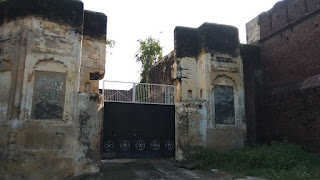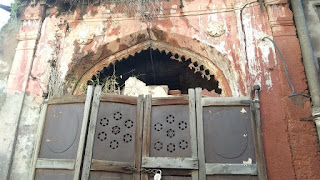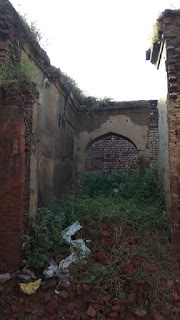SA Site Cover: The Ruins of Payal, Ludhiana by Rattan Kaur Rainu
“Defaced ruins of
architecture and statuary, like the wrinkles of decrepitude of a once
beautiful woman, only make one regret that one did not see them when they were
enchanting.”
- Horace Walpole
 |
Rattan Kaur Rainu is a Research Wing member
at Speaking Archaeologically since August 2018 |
Goethe said architecture is music. Well,
architecture and music are the two things that have always been my favourite. Be it
an an old abandoned house, or an enthralling corner of a fort, buildings have always appealed to me, maybe because, I am from a city that has been
built, demolished and rebuilt seven times and hence the ruins and the ancient structures have always been my
favourite hangouts.
Even as a kid, during the school picnics, “Delhi darshan” was the time when I used to sneak out an explore the historical spots —abandoned corners of the Tughlaqabad Fort, the coots and haunts of the Hauz Khas— I was always the one to sit and capture the moment, feeling the place, letting its history wash over me; afterall, these were the places where History as we know it today, was born and raised, where it played its games, danced, cried and laughed. This blog is exactly about one such place: the Payal Fort of Ludhiana and here's how I became acquainted with it.
No story should ever start with a funeral and yet, that's exactly how my escapade to Payal Fort began. We were supposed to go to Payal, a small town in Ludhiana District in Punjab, to attend the funeral of my mother’s uncle. Like any person who is likely to be more insensitive than compassionate n an occasion as triste as this, I didn’t want to go but like every other Indian mother, my Mother
also didn’t know the meaning of the word, "No," and so, there I was, along with my little brother, sulking very visibly until I found out about the fort in Payal. Suddenly, the petulant pout vanished and I became all happy and
cheerful— a surprising transformation from the person, who was irritated,
bored and disinterested a minute ago.
Even as a kid, during the school picnics, “Delhi darshan” was the time when I used to sneak out an explore the historical spots —abandoned corners of the Tughlaqabad Fort, the coots and haunts of the Hauz Khas— I was always the one to sit and capture the moment, feeling the place, letting its history wash over me; afterall, these were the places where History as we know it today, was born and raised, where it played its games, danced, cried and laughed. This blog is exactly about one such place: the Payal Fort of Ludhiana and here's how I became acquainted with it.
 |
| Kalgidhari gurudwara, Payal, Ludhiana |
 |
| Payal fort, Payal, Ludhiana |
Now, the task before me was persuading my family to let me visit this place. I made every excuse
possible and after a lot of cajoling, my mother had no choice but to relent. A colourful market welcomed us to the town: bright coloured suits hung on the doors of the shop,
shimmering, sparkling yarns, bright ribbons and bangles— it was a typical, bustling Punjabi small-town market but my eyes were looking for was an
old fort which I couldn’t locate. I wasn't until we reached the Gurudwara, however, and I stepped out of the car, that I finally saw the massive brick fort
I was looking for. Custom demanded, though that, I had to go to Gurudwara, meet the relatives, offer my condolences and pay my respects to the deceased before I could finally slide off the radar and rush to the fort.
At long last, we went there but a big rusty lock on a corroded iron gate welcomed us there and all my excitement turned into despair. I wasn't going to let it go so easily, though. I was adamant that I would go inside and so, I went to the shop adjoining the fort wall. The shopkeeper told us that not many people visited the decrepit monument and so, mostly, it was locked. My brother and I decided that we’d crawl down the gate, regardless because we were too invested to back off now. When we finally managed to cross the first barrier, what should welcome us there but a new gate, which was, much to my dismay, also locked!
My mother and my uncles were waiting for us outside, so we went around, looking for a different
entrance and we spotted a relatively newly built dargah. That, and the tall
fortified bricked walls, were the only accessible parts of the complex. My
brother and I went there and saw an old man sitting, so we asked him to open the gate and told him
that we were from Delhi and came especially to visit the fort. This time, we were in luck and the old man went and
unlocked the rusty gate and now that my family was in there too.
At long last, we went there but a big rusty lock on a corroded iron gate welcomed us there and all my excitement turned into despair. I wasn't going to let it go so easily, though. I was adamant that I would go inside and so, I went to the shop adjoining the fort wall. The shopkeeper told us that not many people visited the decrepit monument and so, mostly, it was locked. My brother and I decided that we’d crawl down the gate, regardless because we were too invested to back off now. When we finally managed to cross the first barrier, what should welcome us there but a new gate, which was, much to my dismay, also locked!
 |
| Dargah Mohammed Ghos Peer, Payal, Ludhiana |
 |
| The entrance to main complex of Payal fort. |
We now asked our saviour, Miya Sahib, to open the gate of the main building, but apparently the keys to that were with a pundit, the caretaker of the fort, who was, at that moment, not on site but in his village instead. It was bit of a shock for
me that an ASI protected monument was not accessible to people before 5 pm. There were also no boards or information available there about
the fort unlike other heritage sites.The internet, too, didn't offer any insights about this place, so we decided to get whatever we could out of Miya Ji.
He told us that this was constructed by Maharaja Amar Singh of Patiala with the Mughal Aid in 1771 CE. He also added
that this place was encroached by the people and that this was once also used as
a Girls' School, that later the Government took over it. The fortified massive
walls were all that I could see but one could
see the entire panoramic view of Payal from up there. Unlike my initial expetations, it turned out that the fort was at the heart of the town and not at its periphery and despite that, it was windy and pleasant, lush green and gorgeous in a way all old places are.The walls had climbers and plants growing in the gaps . I could almost see how alluring the view must have been during the days of Amar Singh.
 |
| Back side of Payal fort |
The architecture and history of these
monuments is crumbling into dust by every passing minute. There is a desperate need to look into their condition. Not
many people know about this fort and countless more will never find out if this blind neglect of heritage continues. If the
restoration and conservation of this old town doesn’t happen soon then we might lose
an important page from our history. There is not much left of the houses, but the Payal Fort stands still in the centre
of the city, mourning the condition of the ruins which once used to
be the splendid havelis.
Yet all is not lost—not yet, at least! The restoration and conversation may revive the town . Also, information boards and signs on the roads and highways to help people locate the Payal fort could increase the tourism in the area. This in turn, may help generate enough funds to restore the heritage structures scattered about the town, even if we ignore the boost it will give the local economy and the employment it would generate for the people of Payal. Thus, the condition of the Payal could bea lot better than what it is today.
The word "payal" etymologically stands for an anklet that elevates the beauty of one’s feet. Maybe the forgotten town called Payal could be elevated to its former grandeur, too.
Yet all is not lost—not yet, at least! The restoration and conversation may revive the town . Also, information boards and signs on the roads and highways to help people locate the Payal fort could increase the tourism in the area. This in turn, may help generate enough funds to restore the heritage structures scattered about the town, even if we ignore the boost it will give the local economy and the employment it would generate for the people of Payal. Thus, the condition of the Payal could bea lot better than what it is today.
The word "payal" etymologically stands for an anklet that elevates the beauty of one’s feet. Maybe the forgotten town called Payal could be elevated to its former grandeur, too.










The insights are amazing, you are indeed a person who is a crazy lover of history.
ReplyDelete❤️
Really an amazing piece of work. Very informative and beautifully written.
ReplyDeleteNice content ����
ReplyDeleteIt was an amazing walk in the city of Payal! :)
ReplyDeleteCongratulations Rattan! So glad to see you fall in love with archaeology. Great beginning for an endless journey of explorations. Keep it going!
ReplyDelete😍😍😍😍 Congratulations on your first blog first of all.. However it doesn't seem that this is the first one 💯 Amazingly portrayed. . Looking forward to our collaboration 💕
ReplyDeleteBeautifully done Rattan mam. A great fan of your work. Heartiest congratulations.
ReplyDeleteVery true
ReplyDeleteU r amazing.....beta .....keep it up .....God Bless U
ReplyDeleteNice didi from jassa
ReplyDelete